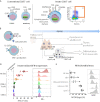Allotransplantation Is Associated With Exacerbation of CD8 T-Cell Senescence: The Particular Place of the Innate CD8 T-Cell Component
- PMID: 34367138
- PMCID: PMC8334557
- DOI: 10.3389/fimmu.2021.674016
Allotransplantation Is Associated With Exacerbation of CD8 T-Cell Senescence: The Particular Place of the Innate CD8 T-Cell Component
Abstract
Immunosenescence is a physiological process that is associated with changes in the immune system, particularly among CD8 T-cells. Recent studies have hypothesized that senescent CD8 T-cells are produced with chronologic age by chronic stimulation, leading to the acquisition of hallmarks of innate-like T-cells. While conventional CD8 T-cells are quite well characterized, CD8 T-cells sharing features of NK cells and memory CD8 T-cells, are a newly described immune cell population. They can be distinguished from conventional CD8 T-cells by their combined expression of panKIR/NKG2A and Eomesodermin (E), a unique phenotype closely associated with IFN-γ production in response to innate stimulation. Here, we first provided new evidence in favor of the innate character of panKIR/NKG2A(+) E(+) CD8 T-cells in normal subjects, documenting their position at an intermediate level in the innateness gradient in terms of both innate IFN-γ production and diminished mitochondrial mass. We also revealed that CD8 E(+) panKIR/NKG2A(+) T-cells, hereafter referred to as Innate E(+) CD8 T-cells, exhibit increased senescent (CD27(-) CD28(-)) phenotype, compared to their conventional memory counterparts. Surprisingly, this phenomenon was not dependent on age. Given that inflammation related to chronic viral infection is known to induce NK-like marker expression and a senescence phenotype among CD8 T-cells, we hypothesized that innate E(+) CD8 T-cells will be preferentially associated with exacerbated cellular senescence in response to chronic alloantigen exposure or CMV infection. Accordingly, in a pilot cohort of stable kidney allotransplant recipients, we observed an increased frequency of the Innate E(+) CD8 T-cell subset, together with an exacerbated senescent phenotype. Importantly, this phenotype cannot be explained by age alone, in clear contrast to their conventional memory counterparts. The senescent phenotype in CD8 T-cells was further increased in cytomegalovirus (CMV) positive serology transplant recipients, suggesting that transplantation and CMV, rather than aging by itself, may promote an exacerbated senescent phenotype of innate CD8 T-cells. In conclusion, we proposed that kidney transplantation, via the setting of inflammatory stimuli of alloantigen exposure and CMV infection, may exogenously age the CD8 T-cell compartment, especially its innate component. The physiopathological consequences of this change in the immune system remain to be elucidated.
Keywords: NK-like T-cells; allotransplantation; immune memory; innate memory CD8(+) T-cells; innateness gradient; senescence.
Copyright © 2021 Daniel, Tassery, Lateur, Thierry, Herbelin, Gombert and Barbarin.
Conflict of interest statement
The authors declare that the research was conducted in the absence of any commercial or financial relationships that could be construed as a potential conflict of interest.
Figures






Similar articles
-
Evidence for eomesodermin-expressing innate-like CD8(+) KIR/NKG2A(+) T cells in human adults and cord blood samples.Eur J Immunol. 2015 Jul;45(7):1926-33. doi: 10.1002/eji.201545539. Epub 2015 May 20. Eur J Immunol. 2015. PMID: 25903796
-
The immune system in extreme longevity.Exp Gerontol. 2008 Feb;43(2):61-5. doi: 10.1016/j.exger.2007.06.008. Epub 2007 Jul 4. Exp Gerontol. 2008. PMID: 17870272 Review.
-
Recall response to cytomegalovirus in allograft recipients: mobilization of CD57+, CD28+ cells before expansion of CD57+, CD28- cells within the CD8+ T lymphocyte compartment.Transplantation. 1997 Mar 15;63(5):693-8. doi: 10.1097/00007890-199703150-00014. Transplantation. 1997. PMID: 9075840
-
Regulation of Adaptive NK Cells and CD8 T Cells by HLA-C Correlates with Allogeneic Hematopoietic Cell Transplantation and with Cytomegalovirus Reactivation.J Immunol. 2015 Nov 1;195(9):4524-36. doi: 10.4049/jimmunol.1401990. Epub 2015 Sep 28. J Immunol. 2015. PMID: 26416275 Free PMC article.
-
NK-like CD8 T cell: one potential evolutionary continuum between adaptive memory and innate immunity.Clin Exp Immunol. 2024 Jul 12;217(2):136-150. doi: 10.1093/cei/uxae038. Clin Exp Immunol. 2024. PMID: 38651831 Free PMC article. Review.
Cited by
-
Editorial: Immunosenescence in organ transplantation.Front Transplant. 2024 Jun 14;3:1422358. doi: 10.3389/frtra.2024.1422358. eCollection 2024. Front Transplant. 2024. PMID: 38993765 Free PMC article. No abstract available.
-
Impact and potential value of immunosenescence on solid gastrointestinal tumors.Front Immunol. 2024 Jun 28;15:1375730. doi: 10.3389/fimmu.2024.1375730. eCollection 2024. Front Immunol. 2024. PMID: 39007138 Free PMC article. Review.
-
Virtual Memory CD8+ T Cells: Origin and Beyond.J Interferon Cytokine Res. 2022 Dec;42(12):624-642. doi: 10.1089/jir.2022.0053. Epub 2022 Sep 9. J Interferon Cytokine Res. 2022. PMID: 36083273 Free PMC article. Review.
-
Early activation and recruitment of invariant natural killer T cells during liver ischemia-reperfusion: the major role of the alarmin interleukin-33.Front Immunol. 2023 May 9;14:1099529. doi: 10.3389/fimmu.2023.1099529. eCollection 2023. Front Immunol. 2023. PMID: 37228593 Free PMC article.
-
The diseased kidney: aging and senescent immunology.Immun Ageing. 2022 Nov 16;19(1):58. doi: 10.1186/s12979-022-00313-9. Immun Ageing. 2022. PMID: 36384564 Free PMC article. Review.
References
Publication types
MeSH terms
LinkOut - more resources
Full Text Sources
Medical
Research Materials

